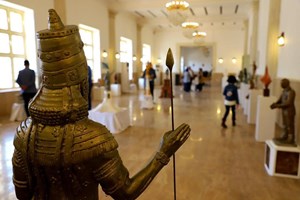
Six years after Daesh attack, the Mosul Cultural Museum is being rehabilitated through the commitment of Iraqi authorities and an international heritage consortium.
In 2015, the Mosul Cultural Museum in Iraq was attacked by ISIS, the extremist, terrorist organization locally known as Daesh. They posted videos of its adherents toppling the museum’s ancient statues, smashing artefacts off the wall, burning documents and severely damaging its main building.
Six years later, emergency repairs have begun and the museum is well on its way to restoration. This is a result of a coalition of international groups including the Smithsonian Institution, Musée du Louvre, World Monuments Fund and the ALIPH Foundation, has joined together with Iraq’s Ministry of Culture and its State Board of Antiquities and Heritage to renovate the buildings and restore collections, install exhibitions, develop visitor amenities and train staff. Since 2018, the founding members of this consortium have been stabilizing the building and the collection housed within it, and training and equipping the Mosul Cultural Museum team, to prepare for the full-scale rehabilitation. In 2020, they were joined by WMF to define the restoration and rehabilitation program. The goal is to return this museum to the citizens of Mosul as quickly as possible, and to allow this important cultural landmark to showcase Iraq’s rich culture once again.

In nearby Nimrud, Iraqi-American teams documented the damage and successfully moved hundreds of tons of massive fragments of shattered monumental sculptures. (Iraqi Institute for the Conservation of Antiquities and Heritage), via smithsonianmag.com
A damage assessment of the collection was also carried out, revealing that much of the collection, including a colossal lion from Nimrud, the Banquet Stela, a monumental Lamassu, and a precious wooden cenotaph, had been heavily damaged, not to mention 25,000 volumes in the library had been burned and many artefacts had disappeared. Based on this assessment and another one of the building, an Action Plan released in November 2019 and coordinated by the Musée du Louvre, determined the next steps for the rehabilitation until the museum’s reopening.
As the first step in the preservation of the collection, the artefact fragments were painstakingly sorted, documented, cleaned, and stored by the Mosul Cultural Museum team with the experts from the Musée du Louvre. To prepare the restoration of the collections, the Musée du Louvre, in close connection with the Mosul Cultural Museum team, delivered conservation equipment and restoration products. The Smithsonian Institution and the team in Mosul then set up a conservation laboratory for urgent first-aid restoration of the objects on site.
In a signal of what is to come, this past November, visitors arrived at the museum’s partially restored royal reception hall in an adjacent older building to admire the contemporary works of Omer Qais, a local Iraqi artist. The staff and local residents took heart from this temporary exhibition as a harbinger of the museum’s eventual recovery.
Dr. Laith Hussein, Director of the State Board of Antiquities and Heritage said: “It is wonderful to see the concerted effort of the international organizations and their fruitful cooperation in the rehabilitation of the Mosul Museum, which preserves the treasures of the Mesopotamian civilization, an important part of global heritage for all humankind.
The peaceful coexistence and cooperation we witness today in Mosul, is a victory of the power of good against the elements of darkness and backwardness. We are very grateful for the excellent work supported by ALIPH and carried out by the Musée du Louvre, the Smithsonian Institution, and World Monuments Fund, collaborating on the rehabilitation of the Mosul Museum”.
Restoring and reopening these historic and educational sites provides Mosul’s citizenry with cultural resources to craft their future and also, eventually, contribute to a revived economy, drawing interest, attracting visitors and fueling local commerce. That future is years away but is nonetheless conceivable and achievable given the proven resilience of our professional and committed colleagues in Iraq.

ArtDependence Magazine is an international magazine covering all spheres of contemporary art, as well as modern and classical art.
ArtDependence features the latest art news, highlighting interviews with today’s most influential artists, galleries, curators, collectors, fair directors and individuals at the axis of the arts.
The magazine also covers series of articles and reviews on critical art events, new publications and other foremost happenings in the art world.
If you would like to submit events or editorial content to ArtDependence Magazine, please feel free to reach the magazine via the contact page.